What Is Programmatic Advertising? How Does It Work? [2024]
Over 90% of all online advertising is purchased programmatically today.
But what IS programmatic advertising, and how did it become such a crucial part of the advertising industry?
We break down the Lumascape and discuss the integral roles of Demand-Side Platforms (DSPs), Ad Exchanges, Supply-Side Platforms (SSPs), and everyone else in between in this ecosystem.
Let’s dive in!
What is Programmatic Advertising?
Programmatic advertising is the use of technology to automate the buying and selling of digital advertising.
Before programmatic, buyers purchased ad inventory manually, reaching out to individual publishers to negotiate rates and share ad creative.
The launch of programmatic allowed advertisers for the first time to target specific audiences and optimize their ad campaigns instantaneously.
This new level of automation and control led to significant time and cost savings.
How Did Programmatic Advertising Get Its Start?
The very first digital ad was transacted non-programmatically.
On October 27, 1994, an ad for AT&T appeared on HotWired.com, better known today as Wired.com.
The ad was novel enough at the time that it achieved a 44% click-through-rate (CTR). Compare this to today’s industry average of 0.05%!

This momentous occasion marked the beginning of a new era in advertising, as advertisers could now reach audiences in a whole new way.
However, the process of buying and selling digital ads was time-intensive, with buying teams like the one at AT&T having to reach out to dozens or even hundreds of individual publishers to place their buys.
This slow and cumbersome process led to the advent of programmatic advertising. There is some debate over when it got its official start, although many credit MediaMath with kicking it off around 2007.
Why is Programmatic Advertising Important?
From 2007 on, programmatic advertising slowly gained momentum, clawing its way up to 10.4% of all global digital display ad spend by 2012.
And then it took off, doubling to nearly 20% the following year, and then doubling again. Initially used for remnant ad inventory, programmatic evolved to include premium inventory as well.
Fast forward to 2024, where eMarketer predicts that the US Display market will transact $168B programmatically, good enough for a 91.5% share of all US display spending.
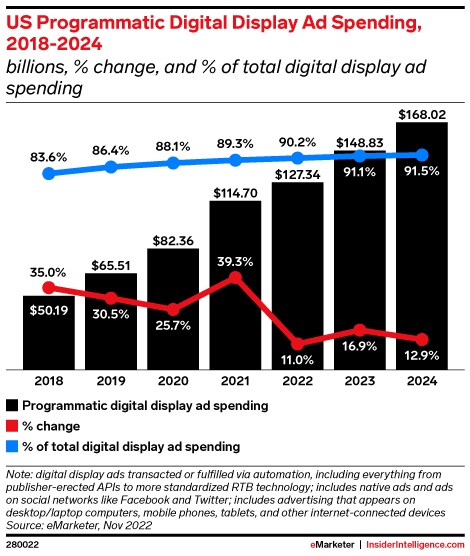
The level of adoption soared rapidly, thanks to the many benefits of programmatic advertising, such as increased efficiency, better targeting, and improved campaign performance.
Additionally, buyers appreciate the level of control and immediacy that programmatic offers, allowing them to quickly react to changes in performance and optimize on the fly.
Who Uses Programmatic Advertising?
Advertisers, publishers, and pretty much everyone in between.
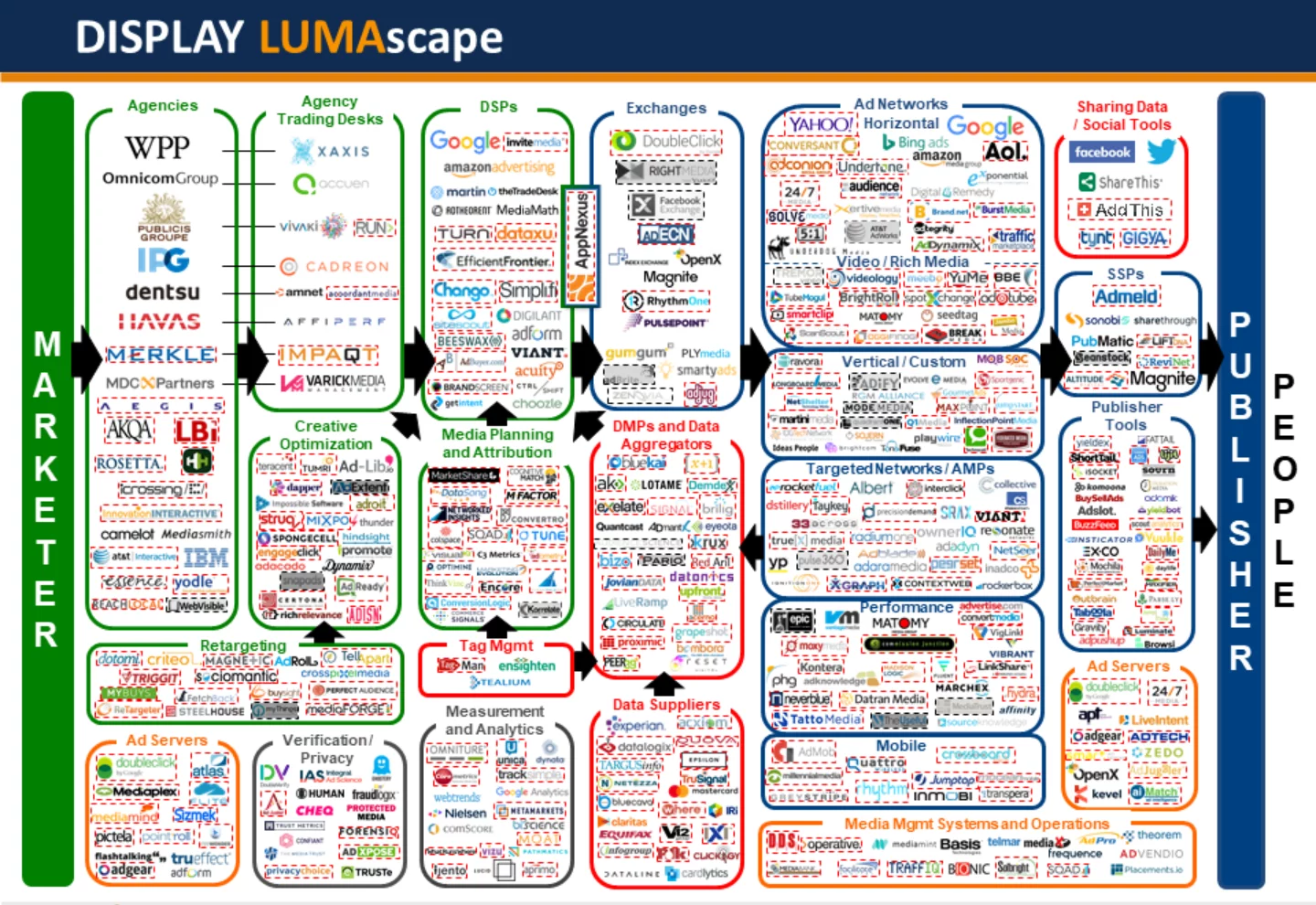
On the advertiser side, businesses small and large almost always buy some media programmatically.
For example, e-commerce companies with large amounts of customer data use programmatic advertising to create highly targeted and personalized ad campaigns, making it particularly popular among them.
On the publisher side, website owners will put their ad inventory up for auction for buyers to bid programmatically. This increases the amount of competition for each ad impression, leading to more revenue for the publisher.
By extension, most adtech players in between are also participating in the programmatic process, from demand-side platforms (DSPs) to ad networks to supply-side platforms (SSPs).
What Levers Can a Buyer Control Through Programmatic Advertising?
Programmatic advertising allows buyers to control a variety of levers, including targeting, bid pricing, ad creative, and frequency capping.
Furthermore, buyers can adjust these levers in real-time, as opposed to having to manually request the publisher make changes on their end and then play the waiting game.
Programmatic Advertising Platforms
Each programmatic transaction involves dozens or even hundreds of adtech firms in the ad auction process.
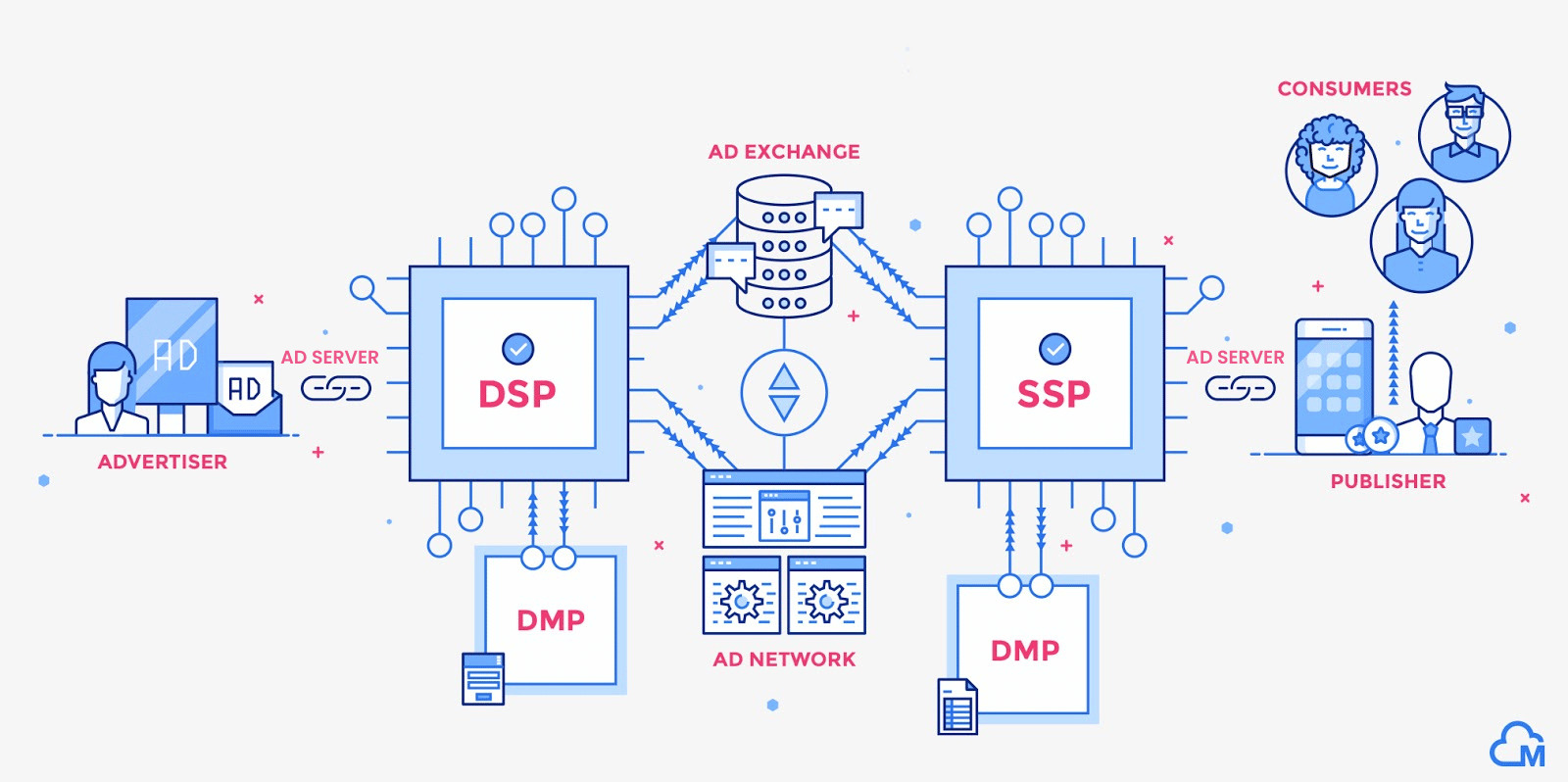
Here are the key participants:
1. Publishers
- Websites or apps that offer advertising space for sale to advertisers.
- Publishers can range from large media companies to individual bloggers or content creators.
2. Publisher Ad Servers
- Technology platforms used by publishers to generate the ad tags that they place on their websites or apps.
- Provide publishers with the ability to manage their advertising partners, set pricing, and track ad performance.
- Provide publishers with tools to manage their direct-sold campaigns and ad network relationships.
3. SSPs (Supply-Side Platforms)
- Software platforms used by publishers to sell ad space to advertisers through various ad exchanges.
- Provide publishers with more control over their ad inventory, allowing them to set pricing floors, manage ad quality, and provide detailed reporting and analytics.
4. Ad Exchanges
- Online marketplaces that connect advertisers and publishers to buy and sell digital advertising inventory.
- Facilitate programmatic advertising transactions by providing a platform for advertisers to bid on ad inventory based on audience and other targeting criteria.
- In many cases, an SSP owns and operates the ad exchange.
5. Ad Networks
- Companies that connect advertisers to a variety of publishers and websites that offer ad space.
- Specialize in specific types of inventory or ad formats and may offer package deals for advertisers to reach a specific audience or market.
- Some ad networks participate in the programmatic ad process, while others operate only non-programmatically.
6. DSPs (Demand-Side Platforms)
- Software platforms that allow advertisers and agencies to purchase ad inventory from a range of ad exchanges and publishers.
- Provide sophisticated targeting capabilities, allowing advertisers to reach specific audiences and optimize their campaigns in real-time.
7. DMPs (Data Management Platforms)
- Technology platforms that collect, organize, and analyze large amounts of data from various sources, including websites, mobile apps, and offline sources.
- Advertisers then use this data to create audience segments for targeting through programmatic advertising.
8. Advertiser Ad Servers
- Technology platforms used by advertisers to manage their ad campaigns and track the performance of their ads.
- Allow advertisers to optimize their campaigns by providing real-time data on ad performance and audience engagement.
9. Advertisers
- Companies or individuals that purchase ad inventory from publishers to promote their products or services.
- Advertisers use technology platforms, such as demand-side platforms, to find and purchase ad inventory from various sources.
- They can target specific audiences based on a range of criteria, including demographics, location, and browsing behavior.
How Programmatic Ad Auctions Work
When a user visits a webpage or app that has ad space available, the publisher’s adserver sends an ad request to multiple partners, most often first going to a supply-side platform (SSP).
The SSP then sends the ad request to an ad exchange, which then sends the request to multiple demand-side platforms (DSPs) that advertisers use to bid on the available ad space.
Each DSP evaluates the ad request based on factors such as the user’s location, browsing behavior, and demographic information, and decides whether or not to place a bid on the available ad impression.
The DSP then submits a bid to the SSP with the amount they are willing to pay for the ad impression.
The SSP collects all the bids from the DSPs and selects the highest bidder. The winning DSP’s adserver then shows an ad to the user on the publisher’s website or app.
This entire process takes only 200 milliseconds on average.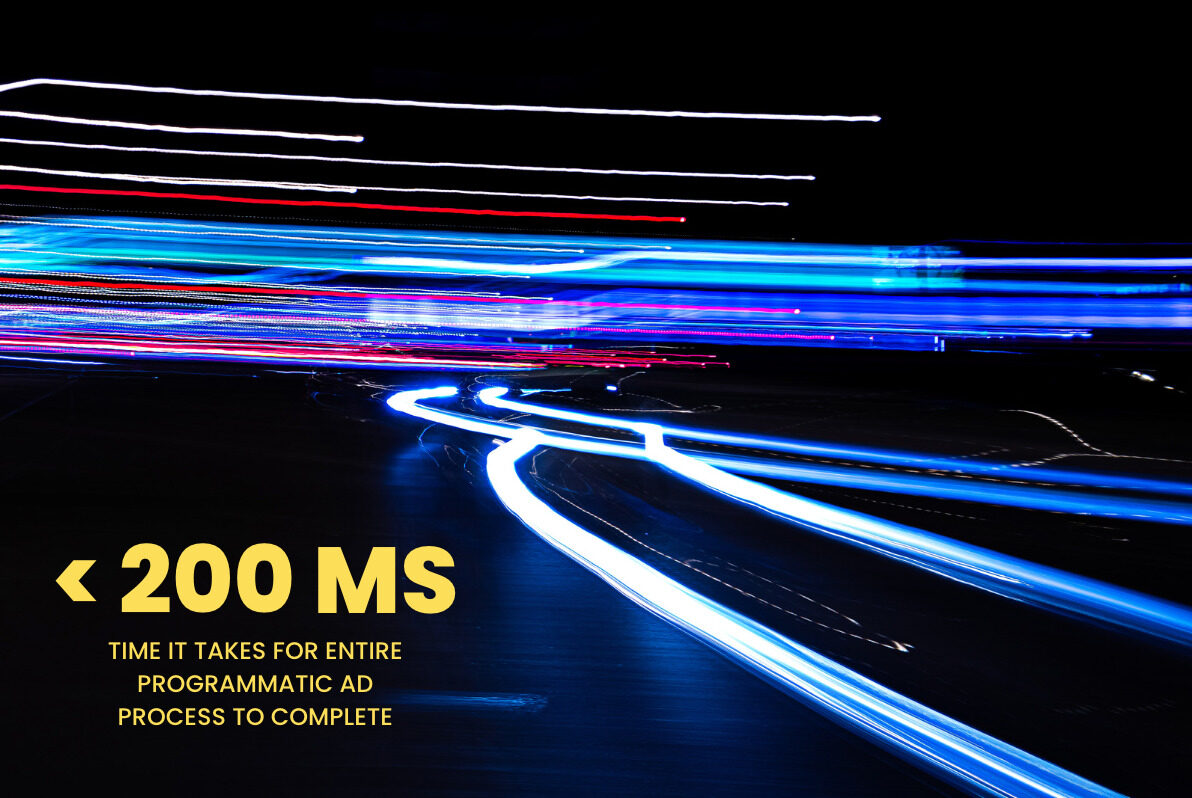
Auction Mechanics
In the world of programmatic ads, auctions can unfold in several ways.
There’s the second-price auction, where the highest bidder pays the amount offered by the second-highest bidder—efficient and economical.
Then there’s the first-price auction, where what you bid is what you pay—it’s clear and uncomplicated.
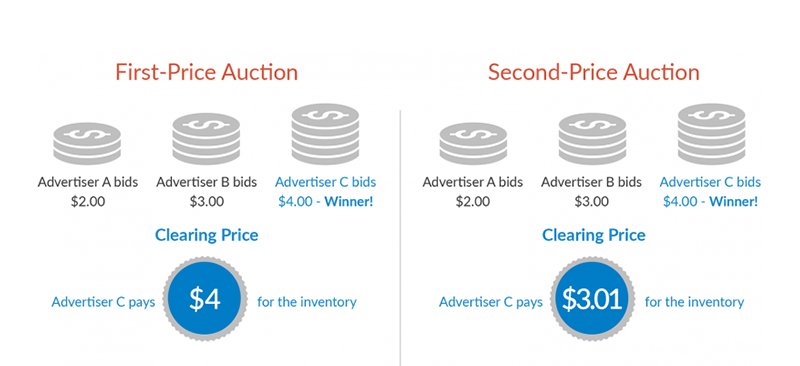
Some ad exchanges even combine elements from both, creating a hybrid auction model.
Understanding these auction mechanics is pivotal for advertisers aiming to maximize the value of their ad spend.
A solid grasp of bid placements and winning impressions allows advertisers to optimize their strategies, ensuring their ads resonate with the desired audience at the right cost.
What is Header Bidding?
Header bidding is a programmatic advertising technique that allows publishers to offer their ad inventory to multiple ad exchanges and SSPs simultaneously, before making calls to their ad servers.
This allows advertisers to bid on inventory that would otherwise be unavailable to them. Traditionally, publishers would prioritize the inventory they sold on their own ad server, and then send any unsold inventory to ad exchanges.
However, this method didn’t always result in the best price for the publisher, and advertisers often missed out on the opportunity to bid on high-quality inventory.
With header bidding, the process works in reverse. Publishers offer their inventory to multiple ad exchanges at the same time, allowing them to receive multiple bids before selecting the highest bidder.
This can lead to increased competition and higher prices for publishers, while giving advertisers more opportunities to buy high-quality inventory.

There are several different types of header bidding, including server-side and client-side header bidding.
Server-side header bidding uses an external server to manage the bidding process, while client-side header bidding manages it within the user’s browser.
Regardless of the type of header bidding implemented, the end goal is the same: equal inventory access for more buyers, and higher prices for publishers.
The 4 Types of Programmatic Deals
There are four types of programmatic deals that advertisers and publishers can use to buy and sell digital ad inventory.
Each deal type offers its own benefits and challenges, and the choice of which type to use often depends on the advertiser’s goals, budget, and targeting needs.
It can be easy to get lost in all of the adtech jargon, so first let’s offer a simple explanation. The publisher has four options in terms of how they can sell an ad impression:
1. Open Auction: available to all buyers on the ad exchange. Highest bidder for the impression wins and serves the ad.
2. Private Auction: available to a subset of buyers that they invite. These invited multiple buyers will then bid for the impression.
3. Preferred Deals: available to only one buyer. The buyer gets a “first look” at it and can decide whether they want to buy it or not.
4. Automated Guaranteed: available to only one buyer. However, in this arrangement, the buyer must buy the impression, as they agree to a set number of impressions and a fixed price ahead of time.
Publishers will often sell some of their ad inventory via automated guaranteed, preferred deal, and/or private auction, and let the remainder go into the open auction pool.
Deal Type Pseudonyms
If the above section didn’t provide enough adtech terminology to confuse you, good news: each of the deal types has multiple names!
1. Open Auction: also may be referred to as Real-Time Bidding (RTB), Open Exchange, Open Marketplace
2. Private Auction: also commonly known as Private Marketplace (PMP) or Closed Auction
3. Preferred Deals: also referred to as Spot buying, Private Access, Unreserved Fixed Rate
4. Automated Guaranteed: also called Programmatic Guaranteed, Programmatic Direct, or Reserved
This handy graphic sums it up nicely:

(In one more confusing twist, you may note that the term “Programmatic Direct” sometimes specifically refers to the fourth deal type, and sometimes it includes all non-Open Auction Deal Types).
Before we move on from deal types, we need to mention one more thing: Deal IDs.
What is a Deal ID?
Every programmatic direct deal that gets negotiated between a buyer and a seller gets its own Deal ID.
A Deal ID serves as a unique identifier, allowing buyers and sellers to track the performance of an ad deal and ensure adherence to the deal’s terms.
The Deal ID format is typically a combination of letters and numbers that create a unique identifier for a specific programmatic advertising deal.
While it can vary depending on the ad exchange or demand-side platform (DSP) in use, it maintains a standardized format to ensure interoperability between different platforms.
The format may include a prefix that identifies the ad exchange, followed by a unique sequence of letters and/or numbers that identify the specific deal.
For example, a Deal ID format for a private deal on the Google Ad Manager platform may look something like “GAM_PD_12345.”
That all may seem like an overly in-the-weeds tidbit, but a buy’s Deal ID is used somewhat interchangeably as the name for the deal itself, and will be featured prominently in reporting.
Advantages of Programmatic Advertising
Programmatic advertising offers several benefits to advertisers, including:
1. Efficiency: advertisers can reach their target audience more efficiently, reducing the time and resources required to purchase ad space manually.
2. Cost-effectiveness: with the sheer volume of programmatic inventory available in the market, selective buyers can find opportunities at lower costs than traditional advertising methods.
3. Targeting capabilities: advertisers can target their ads more precisely, based on factors such as demographics, interests, and behavior.
4. Real-time optimization: programmatic advertising enables advertisers to optimize their ad campaigns in real-time, adjusting their strategy based on the results they are seeing.
Challenges and Risks of Programmatic Advertising
While programmatic advertising offers several benefits, there are also some challenges and risks associated with the use of this technology. These include:
1. Ad fraud: programmatic advertising can be susceptible to ad fraud, where fraudulent websites or bots generate fake impressions or clicks on ads.
2. Brand safety: programmatic advertising can sometimes lead to ads appearing on inappropriate or irrelevant websites, which can harm a brand’s reputation.
3. Data privacy: programmatic advertising relies heavily on audience data, which can raise concerns around data privacy and consumer consent.
4. User experience: the large number of ad calls and partners involved can result in slower page load times and a less seamless user experience. The complex bidding process and the use of multiple third-party technologies can also increase the likelihood of technical glitches or errors.
How Much Does Programmatic Advertising Cost?
The cost of programmatic advertising can vary widely depending on several factors, such as the type of ad format, the targeting options, the competition for ad inventory, and the demand for the ad placement.
In programmatic advertising, ads are typically bought on a cost-per-thousand-impressions (CPM) basis.
The CPM the buyer ultimately pays is usually based on a bidding system, where advertisers bid against each other in real-time for the ad placement.
This can result in higher prices for more competitive ad inventory, such as premium ad slots on popular websites.
In addition to the bidding system, programmatic advertising also involves various fees and charges, such as platform fees, data fees, and transaction fees. These fees can also vary depending on the programmatic platform used and the services provided.
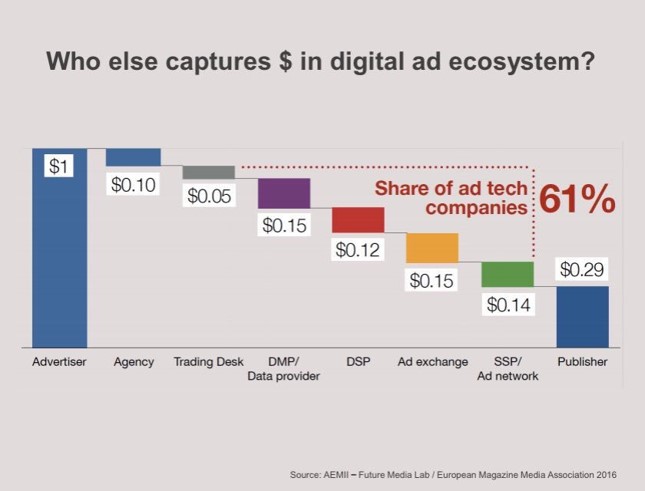
Overall, the winning programmatic bid can be as low as $0.01 CPM or well north of $100 CPM, but rates typically fall in the $0.50-$2.00 CPM range.
It is important for advertisers to carefully consider their budget and goals when planning a programmatic advertising campaign and to work with a reputable programmatic platform or agency to optimize their campaign for the best results and ROI.
Programmatic Advertising Data Management
Programmatic advertising relies on data to make decisions about which ads to serve to which audiences.
Marketers can use these different data sets to inform strategies, audience segmentation, and personalization efforts.
The main types of data used in programmatic advertising are as follows:
1. First-Party Data
First-party data is data that a company collects directly from its own audience or customers.
It includes information such as website analytics, customer purchase history, and interactions with a brand’s owned channels such as social media, email, and mobile apps.
This data is valuable because it is unique to the company that owns it and is often the most accurate and reliable source of information about a company’s audience.
2. Second-Party Data
Second-party data is data a company or organization collects and then shares with another entity.
This data is private and typically not sold to third parties. The entity receiving the data is the second party.
Second-party data can come from various sources such as data exchanges, direct data-sharing agreements, and partnerships.
3. Third-Party Data
Third-party data refers to information collected from sources outside of an organization.
This data can include demographic information, browsing history, online behavior, purchase history, and other relevant data points.
Third-party data providers collect, aggregate, and sell this data to other companies or organizations.
Advertisers will use these various data sets in conjunction with different targeting strategies to accomplish their marketing goals.

4. Zero-Party Data
We’ll go ahead and mention the controversial one here too while we’re at it.
Zero-party data describes data customers intentionally share with a company.
This can include information about their interests, preferences, and intentions.
Customers often provide zero-party data directly through surveys, polls, or subscription preferences, unlike first-party data collected through interactions.
Zero-party data is the newest category, and as such, some marketers view zero-party data as merely a trendy buzzword for first-party data, causing confusion about its role and value in marketing strategies.
Targeting Strategies in Programmatic Advertising
Programmatic advertising offers a range of targeting options to help advertisers reach their target audience more precisely.
Here are the main targeting strategies used in programmatic advertising:
- Demographic targeting: focuses on demographic factors such as age, gender, income, education, and location.
- Psychographic targeting: uses consumer personality traits, values, interests, attitudes, and lifestyle information.
- Behavioral targeting: targets users based on their online behavior, such as search queries, websites visited, and content consumed.
- Contextual targeting: based on the context of the web page users are currently viewing. For example, if a user is reading an article about gardening, an advertiser may serve them ads related to gardening products or services.
- Geotargeting: targets users based on their location. This targeting can occur at granular levels, such as specific zip codes or cities, or broader levels, like entire countries.
- Device targeting: filters for the type of device the user is using, such as desktop, mobile, or tablet. This capability enables advertisers to optimize ads for different devices and ensure proper display.
- Retargeting: finding users that previously interacted with the advertiser’s website or ads. Retargeting allows advertisers to reach users who have already shown interest in their products or services, increasing the likelihood of conversion.
- Lookalike targeting: finds users who have similar characteristics to a brand’s existing customers. Lookalike targeting helps advertisers reach new audiences that are likely to be interested in their products or services.
- Account-based targeting: focuses on specific companies or organizations, rather than individual users. Marketers often use account-based targeting in B2B marketing to connect with decision-makers at target companies.
Audience Targeting
A frequently used term is audience targeting. Technically many of the above are forms of audience targeting: demographic, psychographic, behavioral, retargeting, and lookalike.
However, many times audience targeting is thought of as the combination of demographic, psychographic, and behavioral targeting.
In order to accomplish the desired level of targeting, advertisers may utilize first-party data, second-party data, third-party data or a combination of these data sets.
Ad Creative Formats for Programmatic Advertising
Programmatic advertising supports a variety of ad creative formats, including display ads, video ads, native ads, and audio ads.

Display ads are the most common format, found prominently on websites and mobile apps.
Video ads, on the other hand, are becoming increasingly popular and can be seen on various online platforms, such as social media and streaming services.
Native ads are designed to blend in with the content on the website or app where they appear. They often include sponsored content or articles that are related to the website’s content.
Native ads are popular among advertisers because they tend to be less intrusive than other ad formats, making them more effective at engaging users.
Audio ads are another format that is gaining popularity in programmatic advertising. These ads can be heard on streaming services, such as Spotify or Pandora, and can be targeted based on user behavior, location, and other demographic factors.
Best Programmatic Advertising Platforms
Here are some of the top programmatic advertising platforms in each category:
- DSP: Display & Video 360 (Google), The Trade Desk, Amazon DSP, MediaMath, AppNexus, StackAdapt, Yahoo DSP, Basis DSP
- SSP: Google Ad Manager (GAM), PubMatic, Magnite, OpenX, Amazon Publisher Services (APS), Xandr (Microsoft), Index Exchange, Sovrn
- Ad Exchange: Google Ad Exchange, Pubmatic, Magnite, OpenX Ad Exchange, Xandr (Microsoft), Index Exchange, GumGum, SmartyAds Ad Exchange
- Ad Network: Google Display Network (GDN), Yahoo, Criteo, Facebook Audience Network, Amazon Media Group
- DMP: Lotame Spherical Platform, Permutive, Adobe Audience Manager, Oracle Data Cloud, LiveRamp
Some examples of specialist programmatic advertising platforms include:
- Video DSP: Amobee, Teads
- Mobile DSP: Digital Turbine, InMobi, Adelphic DSP
- Audio SSP: Triton Digital, AdsWizz, TargetSpot
Programmatic Advertising Examples
Programmatic advertising has varied applications. Here are some examples of how different industries put it into action:
- E-commerce: In E-commerce, advertisers use programmatic advertising to display ads for specific products to users who have previously shown interest in those products. For example, if a user visits an e-commerce site and looks at a specific product, they might see ads for that product on other sites they visit later.
Source: Nosto - Travel: Travel advertisers use programmatic advertising to display ads for hotels, flights, and other travel-related products to users planning trips. For example, if a user searches for flights to a specific destination, they might see ads for hotels in that destination.
- Automotive: Automotive advertisers can use programmatic advertising to target users in the market for new cars. For example, if a user visits a car manufacturer’s website and builds a custom car, they might see ads for that car on other sites they visit later.
- Finance: Financial advertisers use programmatic advertising to target users interested in financial products like credit cards, loans, and investment products. For example, if a user searches for “best credit cards,” they might see ads for credit cards on other sites they visit later.
- Healthcare: Healthcare advertisers use programmatic advertising to target users interested in healthcare products and services. For example, if a user searches for “symptoms of the flu,” they might see ads for flu remedies on other sites they visit later.
Steps to Running a Programmatic Advertising Campaign
The first step to running a successful programmatic ad campaign is to set clear campaign goals. This will help you measure the success of your campaign and make informed decisions.
Let’s take a look at some of the most important metrics and key performance indicators (KPIs) to keep in mind.
Programmatic Advertising Metrics and KPIs
Whether you’re assessing user interaction, analyzing performance, monitoring costs, or measuring visibility and exposure, understanding these terms is crucial to optimizing your advertising efforts and achieving your goals.
Below, we’ve categorized essential terms and metrics that advertisers encounter regularly.
User Interaction Metrics
- Clicks: User interactions with an online ad, such as tapping or clicking on any interactive element within the ad.
- Engagement Rate: The percentage of users who interact with an ad, like clicking or watching a video.
- Bounce Rate: The percentage of users who leave after viewing only one page on a website or app.
- Time on Site: The average duration users spend on a site or landing page after clicking on an ad.
Conversion & Performance Metrics
- Conversions: Valuable actions taken by users, like purchases, sign-ups, or downloads.
- Click-Through Conversions: Result from a user clicking on an ad and then completing the conversion.
- View-Through Conversions: Occur when a user sees an ad, doesn’t click on it, but later completes the action on the advertiser’s website.
- Conversion Rate (CVR): The percentage of users who complete a desired action after clicking on an ad.
- Return on Ad Spend (ROAS): The revenue generated per dollar spent on advertising.
- Attribution Window: The timeframe in which an ad can be credited with a conversion.
Cost & Spending Metrics
- Cost per Acquisition (CPA): The cost to acquire a customer through a specific campaign.
- Cost per Click (CPC): The cost for each click on an ad.
- Cost per thousand impressions (CPM): The cost to display an ad one thousand times.
- Cost per Engagement (CPE): The cost for each engagement with an ad.
- Cost per View (CPV): The cost for a single view of a video ad.
Visibility & Exposure Metrics
- Impressions: The number of times an ad is displayed.
- Click-Through Rate (CTR): Measures the effectiveness of an ad in generating clicks, calculated as the number of clicks divided by the number of impressions.
- Viewability: Considers an impression viewable when at least 50% of an ad is in view for at least one second.
- Frequency: The average number of times an ad is shown to the same user.
- Share of Voice (SOV): The advertising presence percentage in a specific market or category compared to competitors.
- Share of Search (SOS): The frequency with which people search for a particular brand or product compared to others in the same category.
Value & Relationship Metrics
- Customer Lifetime Value (CLV): The total value a customer brings to a business over the course of their relationship.
- Customer Retention Rate (CRR): The percentage of customers a company retains over a given period, crucial for understanding customer satisfaction and loyalty.
- Net Promoter Score (NPS): A metric representing customer willingness to recommend a company’s products or services, indicative of customer satisfaction and loyalty
Setting Your Ad Campaign Parameters
With your KPIs set, you still have a few more decisions to make before you’re ready to hit launch.
1. Set Your Advertising Budget
The first step in the programmatic advertising buying process is to set your advertising budget.
Programmatic advertising can be a cost-effective way to reach your target audience, but it’s still important to have an idea of how much you’re looking to spend.
Your budget will determine the number of impressions you can buy, the ad formats you can use, and the targeting options available to you.
You’ll want to balance your budget with your campaign goals to ensure that you’re getting the best possible ROI.
2. Define Your Target Audience
The next step is to define your target audience. This means identifying the demographic, behavioral, and contextual factors that make up your ideal customer.
By defining your target audience, you can ensure that your ads are served to the people who are most likely to engage with them.
3. Choose Your Ad Format(s)
Programmatic advertising allows for a wide range of ad formats, including display, video, and native ads.
Each ad format has its own unique benefits and challenges, so it’s important to choose the format that best suits your campaign goals.
4. Choose Your Attribution Model
An attribution model assigns credit to the touchpoints or interactions leading to a conversion in digital marketing.
It helps marketers understand which marketing channels, ads, or campaigns were most effective in driving a user to take a desired action, such as making a purchase or filling out a form.
Attribution models can vary in complexity, ranging from simple “last click” models, which give all the credit to the last touchpoint before a conversion, to more sophisticated models that consider multiple touchpoints along the user journey and assign credit accordingly.
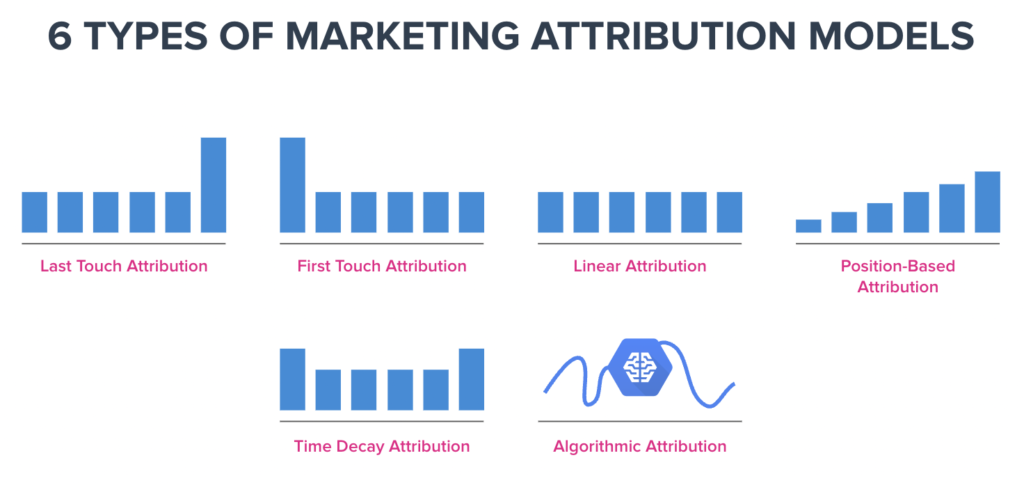
However, keep in mind that no single model is perfect and it may be beneficial to use a combination of models for a more comprehensive understanding of your campaign’s impact.
5. Choose Your Ad Inventory
Where do you want your ads to run?
Some buyers will take a hands-off approach, allowing their campaigns to run across the entire range of inventory that the ad network or ad exchange offers.
This gives them access to some low-cost ad opportunities, but also carries an increased risk of brand safety and poor user experience environments.
Other buyers take a hands-on approach, implementing programmatic direct deals with strategic publisher partners.
For the rest of their programmatic buys, they then use a whitelist or blacklist, carefully crafting where they will and won’t run. Ads running on brand-safe sites are perceived 74% more favorably compared to the same ads seen on brand-unsafe websites.
Launch Your Programmatic Ad Campaign
It’s finally time to launch your campaign!
Now that you are live, you will want to analyze your campaign results throughout the lifetime of the campaign.
Programmatic advertising provides a wealth of data, including impressions, clicks, conversions, and more. By analyzing your results, you can identify areas for improvement and optimize your campaign for better performance.
Techniques for Optimizing Programmatic Advertising Campaigns
As campaign results start rolling in, even if you are crushing your KPIs, there is always room for further improvement.
Here are some of the common optimization techniques you can use to improve campaign performance:
1. Audience targeting: Use audience data to target the right audience. Analyze the performance of your campaigns based on audience demographics, interests, and behavior.
2. Ad creative optimization: Test different ad creatives to see which ones perform the best. Make sure your ads are visually appealing and relevant to your target audience.
3. A/B testing: If you want to take your ad creative optimization to the next level, you can test different elements within the creative, such as ad copy, headlines, and call-to-actions, to see which ones generate the best results.
4. Bid optimization: Analyze bid data to optimize bids for maximum performance. Adjust bids based on ad placement, audience data, and competition.
Understanding Programmatic Advertising Reporting

Programmatic advertising reporting provides valuable insights into campaign performance.
Here are some key components of programmatic advertising reporting:
1. Campaign metrics: Report on key metrics, such as impressions, clicks, conversions, and ROAS.
2. Audience data: Report on audience demographics, interests, and behavior.
3. Ad creative performance: Report on the performance of different ad creatives, including click-through rate (CTR), conversion rate, and cost per conversion.
4. Media placements: Report on where your ads are being shown and the performance of each placement.
5. Bid data: Report on bid prices and performance, including the win rate and the average cost per impression (CPM).
6. Attribution modeling: Use attribution modeling to determine the impact of each touchpoint in the customer journey on conversions and optimize your programmatic advertising accordingly.
Ultimately, the key to successful programmatic advertising is to continuously optimize and improve based on the insights provided by analytics and reporting.
By staying up-to-date with industry trends and best practices, regularly reviewing and analyzing reports, and testing and experimenting with different strategies, you can achieve the best possible results from your programmatic advertising campaigns.
Ethics and Privacy in Programmatic Advertising
As digital advertising has continued to grow, various concerns about ethics and privacy have arisen, especially in recent years.
Advertisers should ensure that their programmatic advertising campaigns are ethical and protect the privacy of their target audience.
This can include using data in a responsible manner, being transparent about data usage, and ensuring that ads are not discriminatory or offensive.
Programmatic Advertising Compliance and Regulations
As with any advertising campaign, programmatic advertising campaigns must adhere to certain compliance and regulatory standards.
Advertisers should ensure that their campaigns comply with applicable laws and regulations, including those related to data privacy, ad content, and transparency.
Some key compliance and regulatory considerations for programmatic advertising campaigns include:
1. General Data Protection Regulation (GDPR):
The GDPR is a set of regulations designed to protect the privacy of individuals in the European Union.
Advertisers should ensure that their programmatic advertising campaigns comply with the GDPR’s requirements related to data privacy and user consent.

2. Federal Trade Commission (FTC) Guidelines:
The FTC provides guidelines related to advertising content, including disclosures and endorsements.
Advertisers should ensure that their programmatic advertising campaigns comply with the FTC’s guidelines.
3. Ad Fraud Prevention:
Ad fraud is a major concern in programmatic advertising, and advertisers should take steps to prevent fraudulent activity.
This can include using fraud prevention tools and partnering with reputable ad networks and exchanges.
4. California Consumer Privacy Act (CCPA):
The CCPA is a privacy law that gives California residents certain rights over their personal information.
Advertisers targeting California residents should comply with CCPA requirements related to data privacy and consumer rights.
5. Children’s Online Privacy Protection Act (COPPA):
COPPA is a federal law that protects the privacy of children under the age of 13 online.
Advertisers must comply with COPPA requirements when targeting children or when collecting data from websites or apps directed towards children.
6. Apple’s App Tracking Transparency Framework (ATT):
Apple’s ATT requires app developers to obtain user consent before tracking their behavior for advertising purposes.
Advertisers must comply with this requirement when running programmatic advertising campaigns on iOS devices.
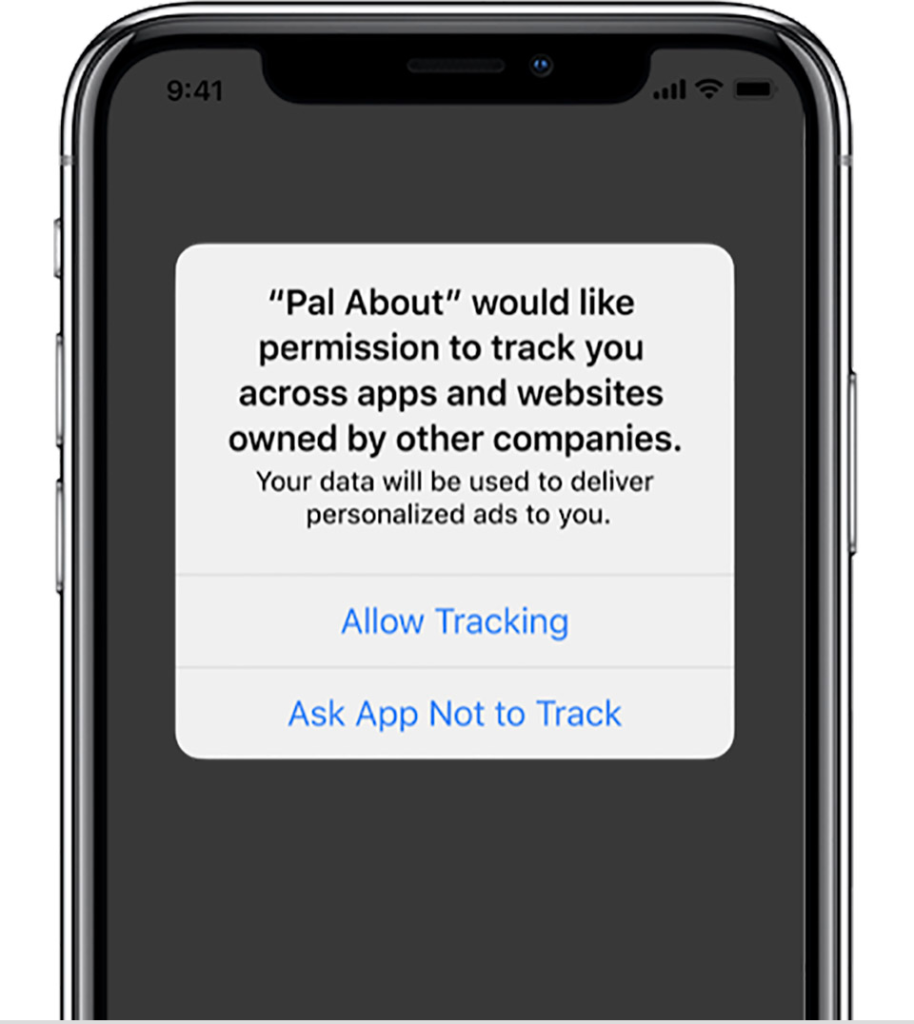
7. Antitrust Scrutiny on Large Walled Gardens:
Large tech companies, commonly referred to as “walled gardens,” have come under increased scrutiny by antitrust regulators in recent years.
Advertisers should stay informed of any potential antitrust actions and be prepared to adjust their programmatic advertising strategies accordingly.
Future Trends in Programmatic Advertising
As programmatic advertising continues to evolve, there are several key trends that are shaping the future of the industry. These include:
1. Artificial Intelligence (AI) and Machine Learning: AI and machine learning have long been used in programmatic advertising to optimize campaigns and improve targeting.
But now, with the rapid evolution of large language models (LLMs) and AI chatbots like OpenAI’s ChatGPT, innovation and change are coming.
There will surely be efficiencies gained and improvements made to current advertising approaches, but there is also a very real threat to the ad-supported open internet that we will have to navigate.
2. Connected TV Advertising: Connected TV (CTV) advertising is becoming increasingly popular as more people cut the cord and rely on streaming services for their entertainment.
CTV advertising leverages the benefits of programmatic by allowing advertisers to target specific households with precision.
3. Programmatic Audio Advertising: Programmatic audio advertising is another emerging trend, allowing advertisers to reach audiences through streaming audio services like Spotify and Pandora.
4. Deprecation of Third-Party Cookies: Major web browsers are phasing out support for third-party cookies, which are commonly used in programmatic advertising to track user behavior.
Advertisers should adapt to this change by using first-party data, contextual targeting, and other methods that do not rely on third-party cookies.

Wrap-Up
Thanks for reading our guide on programmatic advertising! At Ad Ambience, we ensure your brand’s message stands out amidst the ad clutter.
If you want to learn more about how we can help your brand, let’s chat about building a faster, friendlier web together.
Frequently Asked Questions
Programmatic advertising is a method of buying and selling digital ads through automated technology.
Programmatic in marketing refers to the automated buying and selling of digital advertising space in real time, using advanced technology and data-driven strategies to optimize ad delivery and targeting.
Programmatic ads are typically bought through a DSP (Demand-Side Platform) that allows advertisers to access and bid on ad inventory across multiple ad exchanges.
Programmatic mechanics refer to the underlying processes and methodologies involved in programmatic advertising, which automates the buying, placement, and optimization of media inventory via a bidding system.
In simple terms, it’s like the ‘engine’ that powers how ads are bought and sold automatically.
It involves auction dynamics, such as bid strategies and auction types (first-price, second-price), and the ways advertisers can optimize their bids and targeting to ensure their ads are seen by the right audience at the right price.
Programmatic targeting options refer to the strategies advertisers use to reach specific audiences more accurately and efficiently.
This includes behavioral targeting based on user’s online activities, contextual targeting aligning ads with content, and demographic targeting focusing on age, gender, or income.
These options, combined with real-time bidding, enable advertisers to place ads that are more likely to resonate with the user, enhancing the chances of interaction and conversion.
- Dynamic Creative Optimization (DCO): Advertisements are dynamically customized in real-time based on user data, such as demographics, browsing behavior, and location.
- Retargeting: Advertisers serve ads to users who have previously visited their website or shown interest in their products, reminding them and encouraging them to take action.
- Programmatic Direct: Direct deals between advertisers and publishers are facilitated through programmatic technology, streamlining the buying process and offering more control and transparency.
- Video and Connected TV (CTV) Advertising: Programmatic platforms enable the buying and selling of video and CTV ad inventory, allowing advertisers to reach their target audience on streaming platforms and connected devices.
- Mobile In-App Advertising: Programmatic advertising extends to mobile apps, enabling targeted and personalized ads to be delivered within mobile applications.
- Native Advertising: Native ads seamlessly blend with the content of a website or app, offering a non-disruptive and engaging advertising experience.
- Audio Advertising: Programmatic platforms facilitate the buying and selling of audio ad inventory, enabling targeted audio ads to be delivered through streaming services and podcasts.
These are just a few examples of how programmatic advertising is used across various channels and formats to enhance ad targeting, efficiency, and campaign performance.
The cost of programmatic advertising, typically bought on a cost-per-thousand-impressions (CPM) basis, is shaped by various factors including ad format, targeting options, and the competitive nature of the ad inventory.
It operates on a bidding system, often driving up prices for premium slots on popular sites, and incorporates additional varying fees like platform and transaction fees.
Therefore, while bids can range widely, thoughtful planning and collaboration with reputable platforms or agencies are crucial to optimize campaigns for cost and effectiveness.
The Programmatic Lumascape is a visual representation or a map that displays the various companies and technologies involved in the programmatic advertising ecosystem.
It’s like a big, intricate puzzle where each piece is a company that plays a specific role in the process of delivering ads from advertisers to the users’ screens, covering areas such as ad exchanges, data suppliers, and demand-side platforms.
Yes, Facebook offers programmatic advertising options through its ad platform, Facebook Ads Manager.
Advertisers can leverage programmatic capabilities on Facebook to reach their target audience with precision and automation.
Facebook’s programmatic advertising allows for real-time bidding, audience targeting, and automated ad placements across Facebook, Instagram, Audience Network, and other partner apps and websites.
With its vast user base and robust targeting options, Facebook’s programmatic advertising can be a valuable tool for advertisers to effectively reach their desired audience.
There are four types of programmatic deals that advertisers and publishers can use to buy and sell digital ad inventory: open auction, private auction, preferred deal, and automated guaranteed.
A programmatic ad exchange is a digital marketplace that facilitates the buying and selling of online advertising inventory between advertisers and publishers.
It operates in real-time, allowing advertisers to bid on available ad space on websites, apps, or other digital platforms, based on user behavior and other targeting criteria.
In essence, it’s like a stock exchange for ads, where supply and demand determine the value of ad inventory.
Programmatic advertising utilizes automated technology and real-time bidding to buy and place digital ad inventory, allowing for efficient, precise targeting and optimized ad spend.
In contrast, non-programmatic advertising involves manual negotiation and purchasing of ad spaces, often resulting in less efficiency and scalability.
The key difference lies in the automation and data-driven targeting in programmatic advertising, as opposed to the more traditional, manual processes in non-programmatic advertising.
MFA stands for “Made for Advertising”, referring to websites created primarily to earn revenue from ad networks like Google AdSense.
MFA sites typically feature low-quality, thin, or aggregated content and are designed to rank well in search engine results to attract traffic.
The primary goal of these sites is to get users to click on the ads, generating revenue for the site owner, often at the expense of user experience and valuable content.
Programmatic advertising began to take shape around 2007.
The introduction of real-time bidding (RTB) technology in 2009 was a significant milestone, as it allowed for the buying and selling of individual ad impressions in real-time auctions, laying the foundation for the programmatic advertising ecosystem we see today.
The development and advancement of programmatic advertising have been driven by the continuous evolution of digital technology and the increasing need for efficiency and precision in ad targeting.
In programmatic advertising, a Deal ID is a unique identifier used in private marketplace deals between advertisers and publishers.
It acts as a key to unlock specific transaction details, enabling buyers and sellers to track and adhere to the agreed-upon terms and conditions of a deal, such as pricing and inventory.
The Deal ID ensures that both parties adhere to the predefined criteria and allows for more customized, transparent, and efficient transactions within the programmatic ecosystem.
Programmatic advertising is a form of media buying that utilizes automated technology and data to purchase advertising space in real-time, allowing for precise targeting and optimized ad spend.
In contrast, traditional media buying typically involves manual negotiations and purchasing, which can be more time-consuming and less efficient.
Consider media buying the umbrella and programmatic advertising underneath it, representing one way to media buy.
Programmatic ads are purchased and placed through automated, technology-driven platforms, allowing advertisers to target specific audiences and bid for ad spaces in real-time.
On the other hand, direct-sold ads involve a manual, one-to-one transaction where advertisers buy ad spaces directly from publishers, often securing premium placements at a fixed price.
The primary distinction is the automation, flexibility, and targeting precision in programmatic advertising compared to the more traditional, reserved nature of direct sold ads.
Real-time bidding (RTB) is a subset of programmatic buying; it’s the technology that allows for the instant, auction-based purchasing of individual ad impressions, optimizing for price and targeting.
Programmatic buying, on the other hand, is a broader term that refers to the automated purchase of advertising space, whether through real-time auctions or other transaction models like private marketplaces or programmatic direct deals.
The key difference is that RTB is a specific buying mechanism within the wider programmatic advertising ecosystem.
Programmatic advertising is a broad approach that utilizes automated technologies to purchase, place, and optimize digital advertising from multiple ad inventories across the internet, allowing advertisers to target specific audiences effectively.
Google Ads is a specific online advertising platform by Google, allowing advertisers to display advertisements, service offerings, product listings, and video content within the Google ad network.
While Google Ads is a significant player in the space, programmatic advertising encompasses a wider range of platforms, technologies, and marketplaces.
Yes, Google Ads does offer programmatic advertising options through its platform.
It utilizes automated technologies and real-time bidding, allowing advertisers to purchase ad space efficiently, optimize ad placements, and target specific audiences based on various data points.
In this sense, Google Ads is a significant component of the broader programmatic advertising ecosystem.
As of October 2023, Google Ads is still referred to as Google Ads. It was rebranded from “Google AdWords” to “Google Ads” in 2018 to reflect the diversity of advertising options available across its platforms, including Search, YouTube, Google Display Network, and more.
Yes, YouTube offers programmatic advertising options.
Advertisers can use automated buying technologies and real-time bidding to purchase ad space on YouTube, allowing for precise targeting, optimization, and measurement of ad campaigns.
This enables advertisers to efficiently reach their desired audiences with relevant content on the platform.
The most common purchase model in programmatic advertising is Cost Per Mille (CPM), where advertisers pay for every thousand impressions, or views, of their advertisement.
This model, coupled with real-time bidding, allows advertisers to optimize their ad spend, targeting specific audiences and paying based on the number of times their ad is displayed.
The opposite of programmatic advertising is traditional or direct advertising buying.
In this model, ad spaces are purchased through manual negotiations and transactions between advertisers and publishers, without the use of automated technology, real-time bidding, or data-driven targeting.
It typically involves fixed pricing and predetermined placements, offering less flexibility and efficiency compared to programmatic advertising.
In programmatic advertising, three crucial platforms typically work together to facilitate the automated buying and selling of ad space:
Demand-Side Platform (DSP): This platform allows advertisers and agencies to buy ad inventory from publishers across various ad exchanges, enabling them to manage multiple ad and data exchange accounts through one interface.
Supply-Side Platform (SSP): This is used by online publishers to automate the selling of their ad inventory, optimizing the prices they receive for ads.
Ad Exchange: This is a digital marketplace that enables advertisers and publishers to buy and sell advertising space, often through real-time auctions.
These platforms interconnect to form the programmatic advertising ecosystem, allowing for the seamless and efficient transaction of digital ad inventory.

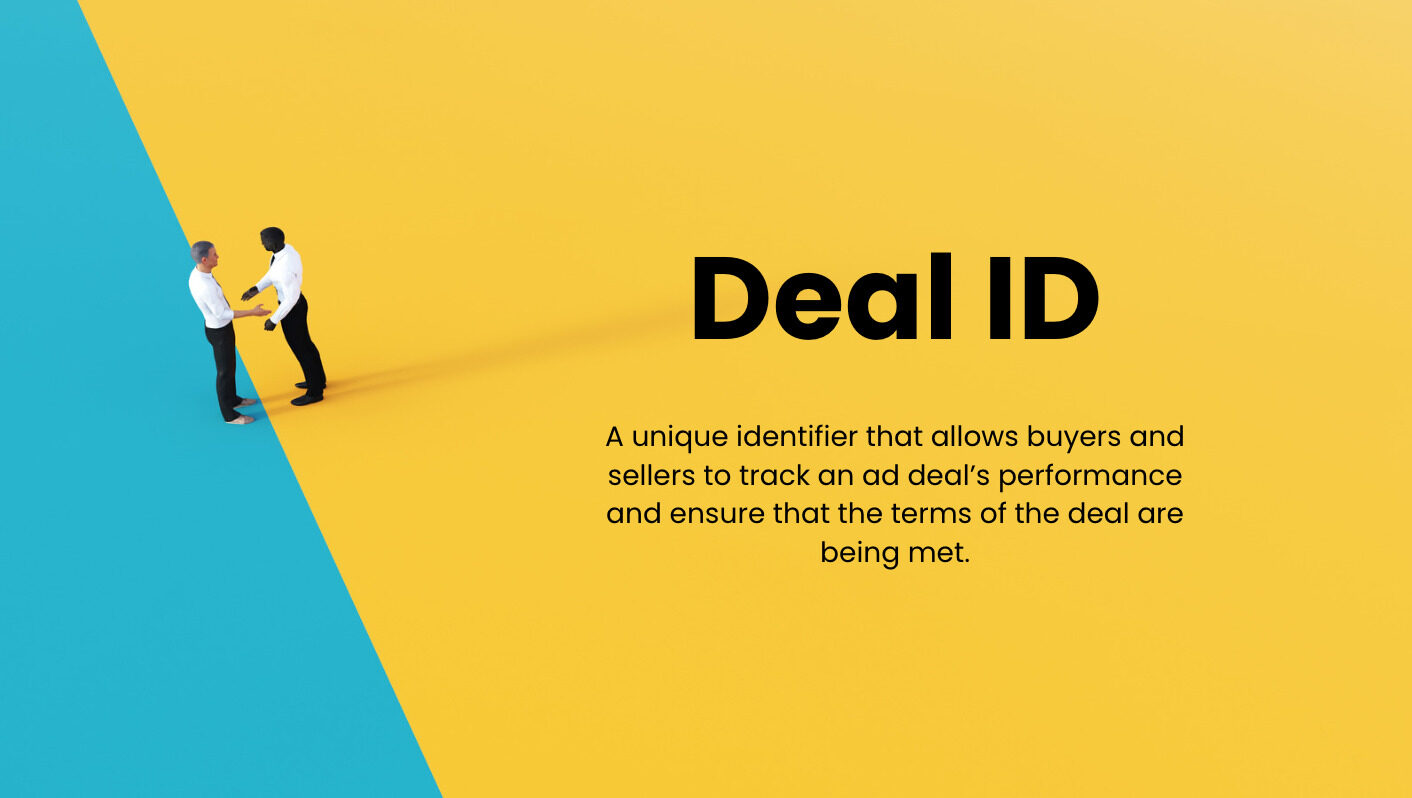






November 9, 2023 @ 8:57 pm
James Jernigan’s YouTube channel serves as an invaluable resource for those hungry for AI knowledge. With each upload, he shares the most recent AI secrets, breaking them down into digestible content. Whether you’re an AI enthusiast or a novice, his channel is your gateway to the world of AI.